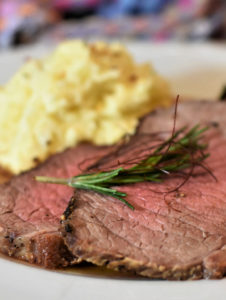The phrase, “where’s the beef?” has special meaning to me. My parents glow with pride as they recount stories of how, at the tender age of three, I would inhale a king-cut portion of prime rib and french fries, then look towards my father’s plate and steal his. One of my mother’s greatest fears in life is that she will one day lose her teeth and no longer be able to gnaw at a steak bone. And I was never more proud of my own daughter than when I watched her bite into her first beef rib at Black’s BBQ while on a family trip to Texas.
The problem with beef, besides the cost, is that it’s not exactly health food. While I personally will always choose a shorter lifespan accompanied by good food over a longer one eating salad, I HAVE finally come to the realization that maybe I should try to instill better eating habits in my daughter since she still has a chance at a healthy lifestyle.
The compromise, then, is to serve a type of beef called eye round. It’s a lot leaner than most other cuts, which makes you feel slightly better about eating more than you should. The challenge, however, is that eye round roasts tend to be dry due to their lack of fat, which makes cooking them properly the entire key to whether or not you’ll enjoy your meal.

EYE ROUND ROAST INGREDIENTS:
- 1 eye round roast (size doesn’t matter, though ours is usually around 2.5 lbs; if yours is larger, adjust the seasonings below so they cover the roast and are proportionate to each other)
- 1 tsp kosher salt
- 1 tsp black pepper
- 1/2 tsp dried thyme
EYE ROUND ROAST INSTRUCTIONS:
- Rinse roast and pat dry with a paper towel.
- Mix seasonings together, then rub them all over meat.
- Let meat sit on counter for 30 min. Preheat oven at that point to 500 degrees (yes, it’s hot. That’s the point. And yes: baking, not broiling).
- Place meat in roasting pan uncovered in the oven; cook for 7 min per pound.
- Turn OFF the oven after this point and leave inside for 2.5 hrs more; DO NOT OPEN THE OVEN DOOR.
- Take out, cover with foil and let sit for 10 min.
- 130-140 degrees F = medium-rare
- 145-150 degrees F = medium

